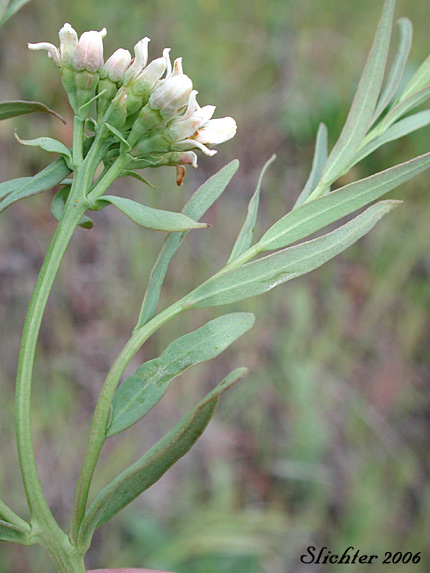 The
photo at right shows the leaves as well as a side-view of the inflorescence of
common bastard toad-flax as seen on sandy soils south ot Interstate 84 about 1
mile east of Celilo, OR........April 24, 2005. Notice the very glaucous
leaves which tend to have only the middle vein visible. The lateral veins are
difficult to see.
The
photo at right shows the leaves as well as a side-view of the inflorescence of
common bastard toad-flax as seen on sandy soils south ot Interstate 84 about 1
mile east of Celilo, OR........April 24, 2005. Notice the very glaucous
leaves which tend to have only the middle vein visible. The lateral veins are
difficult to see.
Bastard toad-flax is a perennial wildflower with clustered stems from 5-30 cm tall arising from shallow to deep-seated rhizomes. The leaves are alternate on the stems and are subsessile to short-petiolate, measuring from 5-40 mm long and 1-10 mm wide with blades linear-elliptic to lanceolate, elliptic, oblong or broadly oblanceolate. The blades range from thin to thick and fleshy and from green on both surfaces to very glaucous.
The inflorescence is a terminal to subternimal cyme of numerous flowers (See photo above.). The calyx is bell-shaped to funnel-shaped with the 5 spreading to suberect lobes white to purplish and narrowly lanceolate to almost ovate in shape. No petals are present. The stamens are about 1 mm long. The fruit is dry to somewhat fleshy, blue to purple or brown in color and 4-8 mm long.
Bastard toad-flax is parasitic on many species of gymnosperms and angiosperms.
Common Bastard Toad-flax: var. californica - Leaves fleshy, strongly glaucous with the secondary veins not visible. The leaf margins are rolled under or if not, then the secondary veins are visible. Calyx lobes ovate or ovate-lanceolate, measuring 2-2.5 mm long. Found west of the Cascade Mts. in western Washington and Oregon south to California and northern Arizona. It is found on the east side of the Cascade Mts from Kittitas County, WA south to the Columbia River Gorge where it intergrades with var. pallida.
Pale Bastard Toad-flax: var. pallida - Leaves thick and very glaucous, the middle vein often visible but not the secondary nerves. Calyx lobes narrowly lanceolate, measuring 3-4 mm long. Found east of the Cascade Mts. from southern British Columbia south through Washington and Oregon to Nevada and east to southwestern Alberta and south through Montana through the western Dakotas to Wyoming, Colorado, Arizona and New Mexico.
var. umbellata: Leaves thinner, usually only slightly glaucous if at all with the secondary veins visible. Found from northern British Columbia south to Nebraska and Kansas and east to Quebec, and hence south to Tennessee and Georgia.
Bastard toad-flax may be found in sandy, well-drained, moist to dry soil from near sea level to subalpine habitats in the mountains.
Bastard toad-flax may be found from northern British Columbia south along the west side of the Cascades to the Sierra Nevada of California and east to the Great Plains. It is common over much of eastern North America.
Variety californica may be found west of the Cascade Mts. in western Washington and Oregon south to California and northern Arizona. It is found on the east side of the Cascade Mts from Kittitas County, WA south to the Columbia River Gorge where it intergrades with var. pallida.